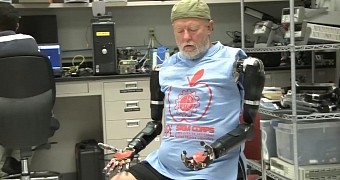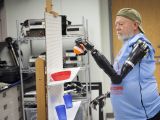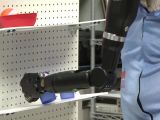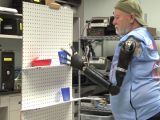A couple of days ago we remarked how impressive it was that a woman paralyzed from the neck down was able to regain some of what she'd lost by means of a prosthetic arm wired straight to her brain. It turns out that there's a man who made history for something like this as well.
Meet Les Baugh, a man who had to have both his arms amputated at the shoulder after an electrical accident that happened 40 years ago.
Back in June this year (2014), he agreed to take part in a research effort funded by the Johns Hopkins University Applied Physics Laboratory, located in Howard County, Maryland, near Laurel and Columbia.
He agreed to undergo a surgery, known as targeted muscle reinnervation, in order to gauge and restore functionality to the nerves that would normally control his arms.
It is a new surgical procedure that reassigns the nerves to other roles, in anticipation of attaching electromechanical prosthetics to the stumps left after amputation.
Baugh successfully controlled two limbs at once
After the surgery, he was outfitted with the limb system you see in the attached gallery (and video) and visited the laboratory for training.
Pattern recognition came first, based on algorithms which identified individual muscles that were contracting, as well as how they intercommunicated. The amplitude and frequency was important.
That information was translated into actual movements by the prosthetic. So it wasn't teaching Baugh how to use the arms as much as programming the limbs to respond as they should.
A custom socket had to be fitted for Baugh's torso and shoulders. The man worked with the limb system through a Virtual Integration Environment (VIE) while the socket got the finishing touches. Basically a virtual reality.
Throughout the test, he was able to move and empty a cup from a counter-shelf to a higher one (eight separate motions in coordination were needed here) and do other actions that would come up during daily activities.
All this after just 10 days of training with the arms, demonstrating that the system was able to integrate the intuitive control normal to humans.
In other words, yes, prosthetics are approaching the Sci-Fi ideal
It shouldn't take more than five to ten years for high-tech prosthetics to reach the level of those seen in Star Wars and most every other Sci-Fi franchise out there. Baugh himself was allowed to go home and see how the limb system integrated with his everyday life. We wish him the best of luck, though it seems he won't need it.

 14 DAY TRIAL //
14 DAY TRIAL // 



